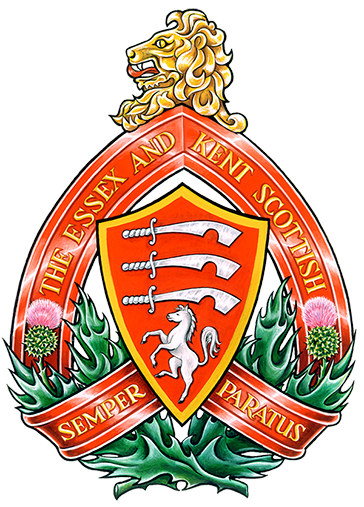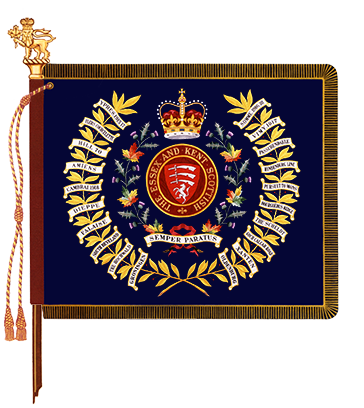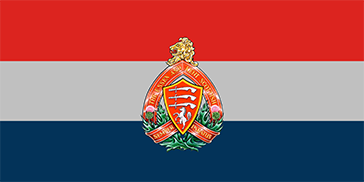The Essex and Kent Scottish
The official lineage of The Essex and Kent Scottish infantry regiment.

Colonel-in-Chief: His Royal Highness, Prince Michael of Kent GCVO
Badge
Description
On a shield Gules fimbriated Or three seaxes in pale points to the sinister, in base a horse forcene Argent, all environed by a scroll Gules ensigned by a lion's head erased Or, reversed at the base, binding two thistles slipped proper, and inscribed in chief THE ESSEX AND KENT SCOTTISH and in base SEMPER and PARATUS in letters Or.
Symbolism
The badge is based on the regimental badge of The Essex Scottish, with the addition of the white horse taken from the badge of The Kent Regiment, which were amalgamated in 1954. The three seaxes refer to the arms of Essex County, England, the location of the regiment's former allied regiment The Essex Regiment (now, through amalgamation, The Royal Anglian Regiment). The white horse is from the arms of Kent County, Ontario and its namesake in England, the location of the regiment's former allied regiment The Queen's Own Royal West Kent Regiment (now, through amalgamation, The Princess of Wales's Royal Regiment). The thistles (the national flower of Scotland) and lion are common devices among badges of highland infantry regiment. "THE ESSEX AND KENT SCOTTISH" is the regimental title and "SEMPER PARATUS" is the motto of the regiment.
Motto
SEMPER PARATUS (Always prepared)
Marches
"The Highland Laddie" and "A Hundred Pipers"
Alliances
British Army
The Princess of Wales's Royal Regiment and The Royal Anglian Regiment
Regimental colour

Camp flag

Battle honours
The War of 1812
DEFENCE OF CANADA – 1812-1815 – DÉFENSE DU CANADA; DETROIT; MAUMEE; NIAGARA
Honorary Distinction
The non-emblazonable honorary distinction DEFENCE OF CANADA – 1812-1815 – DÉFENSE DU CANADA
The First World War
YPRES, 1915, '17; FESTUBERT, 1915; MOUNT SORREL; SOMME, 1916, '18; Flers-Courcelette; Thiepval; Ancre Heights; ARRAS, 1917, '18; Vimy, 1917; HILL 70; Passchendaele; AMIENS; Scarpe, 1918; HINDENBURG LINE; Canal du Nord; Cambrai, 1918; PURSUIT TO MONS; FRANCE AND FLANDERS, 1915-18.
The Second World War
Dieppe; BOURGUÉBUS RIDGE; St. André-sur-Orne; FALAISE; Falaise Road; Clair Tizon; Forêt de la Londe; THE SCHELDT; Woensdrecht; South Beveland; THE RHINELAND; Goch-Calcar Road; The Hochwald; Xanten; Twente Canal; Groningen; Oldenburg; NORTH-WEST EUROPE, 1942, 1944-1945.
South-West Asia
AFGHANISTAN
Lineage
This Reserve Force regiment originated on 12 June 1885 and incorporates the following regiments.
The Essex and Kent Scottish originated in Windsor, Ontario on 12 June 1885, when the '21st "Essex" Battalion of Infantry' was authorized to be formed.Footnote 1 It was redesignated: '21st Battalion "Essex Fusiliers"' on 4 February 1887;Footnote 2 '21st Regiment "Essex Fusiliers"' on 8 May 1900;Footnote 3 'The Essex Fusiliers' on 29 March 1920;Footnote 4 'The Essex Scottish' on 15 July 1927;Footnote 5 '2nd Battalion, The Essex Scottish' on 7 November 1940;Footnote 6 and 'The Essex Scottish' on 15 December 1945.Footnote 7 On 1 October 1954, it was amalgamated with 'The Kent Regiment' (see below) and redesignated 'The Essex and Kent Scottish'.Footnote 8
Notes:
No lineal connection with the '23rd "Essex Battalion of Light Infantry"' of 1866 to 1870.
Upon redesignation as The Essex Fusiliers on 29 March 1920 (see above), it was organized as a three battalion regiment with the 1st Battalion (18th Battalion, CEF) on the Non Permanent Active Militia order of battle, and the 2nd Battalion (99th Battalion, CEF) and 3rd Battalion (241st Battalion, CEF) on the Reserve order of battle. The reserve units were disbanded on 14 December 1936 (GO 3/37).
The Essex Fusiliers were disbanded for the purpose of reorganization on 1 March 1921 and reorganized the same day (GO 118/21). This change was administrative and does not affect the lineage of the regiment.
On 7 March 1962, it was organized as a two battalion regiment (CAO 110-3, Pt 'B', Supp Issue No. 718/62). On 31 March 1965, the '1st' and '2nd Battalion' were amalgamated and redesignated 'The Essex and Kent Scottish' (SD 1 Letter No. 64/61, F 1901-3 (DO), 17 December 1964).
The Kent Regiment originated in Chatham, Ontario on 1 January 1901, when the '24th "Kent" Regiment' was authorized to be formed.Footnote 9 It was redesignated 'The Kent Regiment' on 29 March 1920.Footnote 10 On 15 December 1936, it was amalgamated with 'B Company' of the '2nd Machine Gun Battalion, CMGC' (now 'The Royal Canadian Regiment') and redesignated 'The Kent Regiment (Machine Gun).Footnote 11 It was redesignated: '2nd (Reserve) Battalion, The Kent Regiment (Machine Gun)' on 7 November 1941;Footnote 12 '2nd (Reserve) Battalion, The Kent Regiment' on 1 April 1941;Footnote 13 and 'The Kent Regiment' on 30 March 1946.Footnote 14 On 1 October 1954, it was amalgamated with 'The Essex Scottish', as above.
Notes:
No lineal connection with the '24th "Kent" Battalion of Infantry' of 1866 to 1892.
Upon redesignation as The Kent Regiment on 29 March 1920 (see above), it was organized as a two battalion regiment with the 1st Battalion (186th Battalion, CEF) on the Non Permanent Active Militia order of battle, and the 2nd Battalion (no CEF designation) on the Reserve order of battle. The reserve unit was disbanded on 14 December 1936 (GO 3/37).
The Kent Regiment was disbanded for the purpose of reorganization on 15 February 1921 and reorganized the same day (GO 118/21). This change was administrative and does not affect the lineage of the regiment.
The Kent Regiment was disbanded for the purpose of amalgamation on 14 December 1936 and reorganized the next day (GO 146/36). This change was administrative and does not affect the lineage of the regiment.
The perpetuation of the 2nd Machine Gun Battalion, CMGC (1919- 1936) was assigned to The Canadian Fusiliers (City of London Regiment) (Machine Gun) (now The Royal Canadian Regiment) (GO 148/36).
Perpetuations
‘The Loyal Essex Volunteers (Essex Rangers)’, ‘The Loyal Kent Volunteers (Kent Rangers)’, ‘The Western Rangers (Caldwell’s Rangers)’, ‘1st and 2nd Regiments of Essex Militia (1812-15)’, ‘1st Regiment of Kent Militia (1812-15)’, '18th', '99th', '186th' and '241st "Overseas" Battalion(s), CEF'
Headquarters Location
Windsor, Ontario
Operational history
The First World War
Details of the 21st Regiment "Essex Fusiliers" were placed on active service on 6 August 1914 for local protection duties.Footnote 15
Details of the 24th "Kent" Regiment were placed on active service on 6 August 1914 for local protection duties.Footnote 16
The 18th Battalion, which was authorized on 7 November 1914 as the '18th Battalion, CEF',Footnote 17 embarked for Great Britain on 18 April 1915.Footnote 18 It disembarked in France on 15 September 1915, where it fought as part of the 4th Infantry Brigade, 2nd Canadian Division in France and Flanders until the end of the war.Footnote 19 The battalion was disbanded on 15 September 1920.Footnote 20
The 99th Battalion, which was authorized on 22 December 1915 as the '99th "Overseas" Battalion, CEF',Footnote 21 embarked for Great Britain on 31 May 1916.Footnote 22 On 6 July 1916, its personnel were absorbed by the '35th Reserve Battalion, CEF' to provide reinforcements to the Canadian Corps in the field.Footnote 23 The battalion was disbanded on 1 September 1917.Footnote 24
The 186th Battalion, which was authorized on 15 July 1916 as the '186th "Overseas" Battalion, CEF',Footnote 25 embarked for Great Britain on 28 March 1917.Footnote 26 On 7 April 1917, its personnel were absorbed by the '4th Reserve Battalion, CEF' to provide reinforcements to the Canadian Corps in the field.Footnote 27 The battalion was disbanded on 15 September 1917.Footnote 28
The 241st Battalion, which was authorized on 15 July 1916 as the '241st "Overseas" Battalion, CEF',Footnote 29 embarked for Great Britain on 29 April 1917.Footnote 30 On 7 May 1917, its personnel were absorbed by the '5th Reserve Battalion, CEF' to provide reinforcements to the Canadian Corps in the field.Footnote 31 The battalion was disbanded on 1 September 1917.Footnote 32
The Second World War
The Essex Scottish mobilized the 'The Essex Scottish Regiment, CASF' for active service on 1 September 1939.Footnote 33 It embarked for Great Britain on 16 July 1940.Footnote 34 It was redesignated the '1st Battalion, The Essex Scottish Regiment, CASF' on 7 November 1940.Footnote 35 The battalion took part in the raid on Dieppe on 19 August 1942.Footnote 36 It landed again in France on 5 July 1944, as part of the 4th Infantry Brigade, 2nd Canadian Infantry Division, and it continued to fight in North-West Europe until the end of the war.Footnote 37 The overseas battalion was disbanded on 15 December 1945.Footnote 38
The Kent Regiment (Machine Gun) mobilized 'The Kent Regiment, CASF' for active service on 24 May 1940.Footnote 39 It was redesignated the '1st Battalion, The Kent Regiment, CASF' on 7 November 1940.Footnote 40 It served in Canada in a home defence role as part of the 14th Infantry Brigade, 8th Canadian Division and with Pacific Command.Footnote 41 The battalion was disbanded on 30 March 1946.Footnote 42
South-West Asia
From 2002 to 2014, The Essex and Kent Scottish reinforced various CAF units deployed to Afghanistan.Footnote 43
Page details
- Date modified: